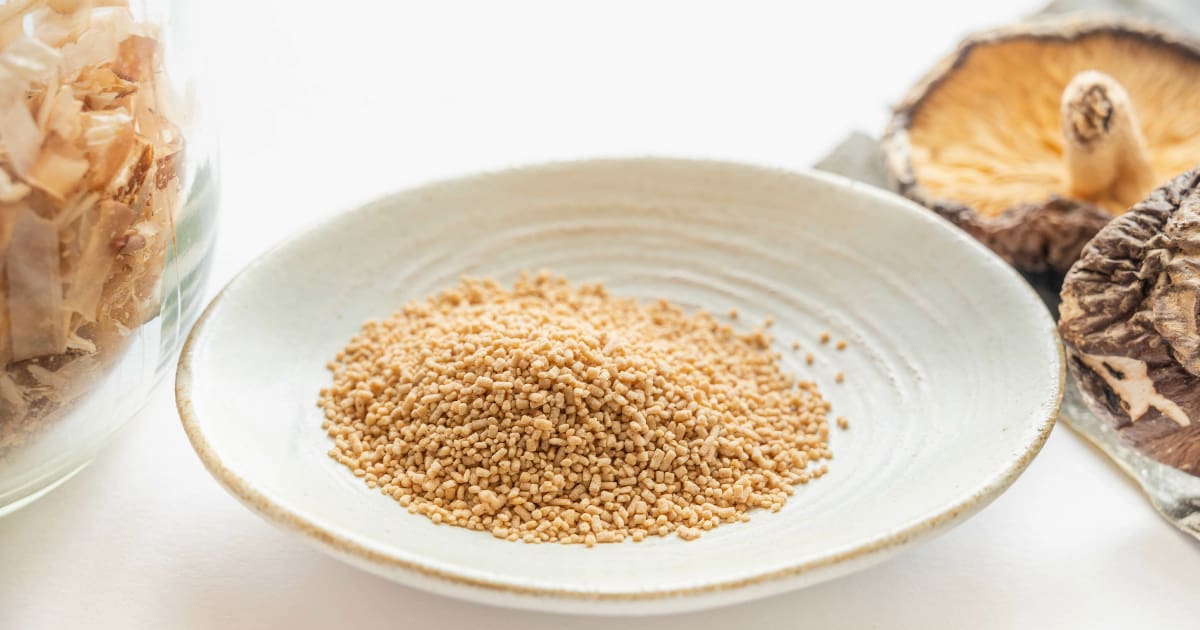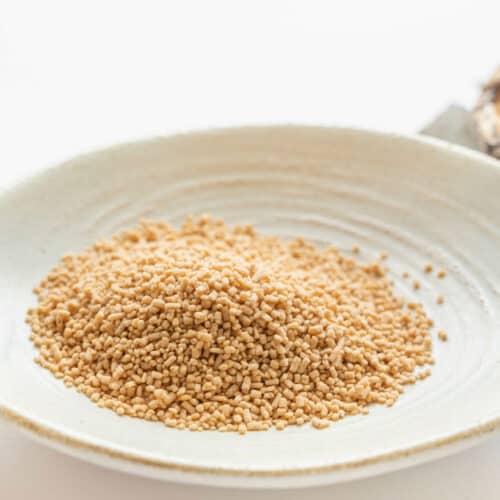Dashi powder is an essential ingredient in Japanese cuisine that adds savory umami flavor to dishes.

Making your own dashi powder at home allows you to control the ingredients and is relatively easy with just kombu seaweed and bonito flakes. This article provides a step-by-step guide to making dashi powder from scratch.
Dashi powder, also called hondashi, is a dried, granulated form of dashi stock. Dashi is the fundamental stock used across Japanese cooking, made by steeping kombu seaweed and bonito fish flakes in hot water to extract the savory umami flavors.
Dashi Powder Ingredients
To make your own dashi powder at home, you only need 2 main ingredients:
Kombu
Kombu is a type of edible kelp that grows in the seas of Japan and Korea. It has a rich, umami taste when rehydrated and infuses dashi with flavor. Look for sheets of dried kombu specifically labeled as "dashi kombu" at Asian grocery stores or online.
Bonito Flakes
Also called katsuobushi, these are shavings of dried, fermented, and smoked skipjack tuna or bonito fish. They impart dashi with a smoky, savory taste. Find them near other Asian ingredients or dried seafood at specialty markets or online.
Equipment Needed
Simple kitchen tools are all you need:
- Stock pot
- Fine mesh strainer or cheesecloth
- Ice cube trays
- Blender or food processor
Step-By-Step Instructions

Homemade Dashi Powder Recipe
Ingredients
- Kombu
- Bonito Flakes
Instructions
- Wipe kombu - First wipe the kombu with a damp cloth to remove white powder on the surface, which is mostly salt that can make your dashi too salty.
- Simmer kombu - Place wiped kombu in a pot with 4 cups water. Let soak 30 minutes then slowly bring to a low simmer. Just before boiling, remove kombu with tongs and discard. This infuses the water.
- Steep bonito - Add your bonito flakes and turn off the heat. Let bonito steep 10 minutes then strain through a fine mesh strainer or cheesecloth. Discard solids.
- Freeze dashi - Pour strained dashi into ice cube trays and freeze until solid.
- Blend cubes - Pop frozen dashi cubes into a blender or food processor. Blend, pulsing, until a fine powder forms. This may take a few minutes.
- Store - Transfer finished dashi powder into an airtight container. Store in a cool, dry place for up to 6 months.
And that's it - you now have homemade dashi powder ready to use in all kinds of Japanese recipes!
How to Use Dashi Powder
Reconstituting dashi broth from the powder takes seconds. Here are some usage tips:
- For dashi broth - Add 1 teaspoon powder per 1 cup hot water and stir to dissolve.
- Adjust salt in recipes since dashi powder contains some. Taste before seasoning more.
- Sprinkle powder into simmering soups, stir fries, braises and more.
- Make classic miso soup by dissolving miso paste into dashi broth.
- Use to season rice, roasted vegetables, popcorn or anywhere you want umami burst.
- Add to marinades, dressings, and sauces in small amounts.
Experiment creatively with homemade dashi powder to boost savory umami flavor!
Tips for Best Results
Follow these tips when making and storing your homemade dashi powder:
- Seek out high-quality Japanese kombu and bonito flakes for best flavor
- Store in an airtight container in a cool, dark place up to 6 months
- Avoid humidity that makes powder clump
- Start with a small amount when using and adjust more to taste
- Combine with soy sauce and mirin for a shiro dashi hybrid seasoning
Key Takeaway: Making dashi powder at home gives you control over quality ingredients resulting in pure, intensely umami flavor for Japanese cooking. Follow the simple steps using kombu and bonito flakes.
Alternative Vegan Dashi Powder
Dashi made in the traditional manner uses bonito fish, but vegan dashi powder variants exist using purely plant-based ingredients.
To make a vegan dashi powder:
- Soak and simmer sheets of dried kombu seaweed in water as above
- Add dried shiitake mushrooms instead of bonito flakes
- Follow same steps to strain, freeze, and blend the kombu mushroom dashi into powder
The result lacks the smoky notes from bonito but still provides hearty umami richness. Use this dashi powder in vegetarian or vegan Japanese dishes.
Dashi Powder vs. Instant Dashi Packets
So is it still worth making dashi powder from scratch when instant options exist? Here's a comparison:
| Dashi Powder | Instant Dashi Packets |
|---|---|
| Full control over ingredients | Contains MSG, additives |
| Intense from scratch umami | Subtler flavor |
| Takes time to make | Just add to hot water |
| Keeps months refrigerated | Shorter shelf life |
Homemade dashi powder without any additives or MSG provides purer flavor. But instant dashi packets offer convenience when time is limited. Choose whichever fits your needs!
Using Dashi Powder in Soup Recipes
Dashi forms the flavor base of many classic Japanese soups and hot pot dishes. Here are some examples where dashi powder comes in handy:
Miso Soup
Miso soup gets its savory umami intensity from dashi and miso paste. Stir miso into dashi broth made from the powder to finish this everyday Japanese soup.
Udon Noodle Soup
For noodle soups, simply reconstitute dashi broth with the powder and add your cooked noodles and toppings like scallions, mushrooms, or tempura bits.
Hot Pot
Creating the cooking broth for sukiyaki, shabu shabu, or other Japanese hot pot dishes? Use dashi powder combined with soy sauce, mirin, and sake as the base.
Dashi truly is the backbone of Japanese soups and simmered dishes thanks to its highly condensable powder form. Keep a stash in your pantry to quickly craft authentic Japanese cuisine!
Key Takeaway: As the fundamental flavor base, dashi powder simplifies making Japanese soups, noodle broths, hot pots and more by instantly infusing rich umami taste into liquid.
FAQs
Can I use a blender instead of food processor to make dashi powder?
Yes, a regular blender will work to grind the frozen dashi cubes into powder. Just use short pulses and shake/stir periodically since dashi can stick to the blender jar. Expect it to take 5+ minutes to get a fine powder.
Is dashi powder gluten-free?
Authentic Japanese dashi powder containing only kombu seaweed and bonito flakes is naturally gluten-free. Always check labels though, as some instant mix products add wheat flour or maltodextrin.
Can I adjust kombu and bonito amounts in my dashi powder?
Yes, you can customize the kombu to bonito ratio based on your taste preferences. Use more bonito for a richer, smokier flavor or increase the kombu for more seaweed umami.
How long does homemade dashi powder last refrigerated?
Properly stored in an airtight container, homemade dashi powder keeps for up to 6 months refrigerated. If it absorbs moisture and clumps, it will deteriorate faster.
What's the ratio of dashi powder to water to make broth?
The standard ratio is 1 teaspoon of dashi powder per 1 cup of hot water to reconstitute broth. But adjust more powder for a stronger or lighter dashi depending on the recipe.
Conclusion
Making your own kombu and bonito based dashi powder enables deeply savory umami flavor in Japanese home cooking.
Follow the easy DIY method to create a versatile dried seasoning that stores conveniently and elevates everyday dishes.
Resources:
- Just One Cookbook: This link provides a recipe and video for making Japanese soup stock with dashi powder, along with information on using dashi packets as a quick alternative.
- Bon Appétit: This article discusses instant dashi as a convenient and flavorful shortcut for making dashi, and how it can be used to enhance the flavor of various dishes.
- Chopstick Chronicles: This page explains the use of dashi granules and dashi packs as a convenient way to make dashi instantly, and provides information on where to purchase them and how to use them in cooking.
- Just One Cookbook: This link offers a recipe and video for using dashi packets as an alternative to making dashi from scratch, along with information on a recommended dashi packet brand.
- Pups with Chopsticks: This page provides information on the flavor and use of dashi powder, including how to substitute it and where to purchase it, both in stores and online.

